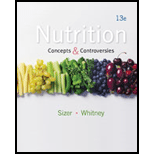
Nutrition: Concepts and Controversies
13th Edition
ISBN: 9781133603184
Author: Frances Sizer, Ellie Whitney
Publisher: Cengage Learning
expand_more
expand_more
format_list_bulleted
Concept explainers
Question
Chapter 10, Problem 5SC
Summary Introduction
Introduction:
Carbohydrates, fats and proteins are the organic compounds which are utilized and broken down by the cells of body to gain energy for all the activities of our body.
Expert Solution & Answer
Want to see the full answer?
Check out a sample textbook solution
Chapter 10 Solutions
Nutrition: Concepts and Controversies
Knowledge Booster
Learn more about
Need a deep-dive on the concept behind this application? Look no further. Learn more about this topic, health-nutrition and related others by exploring similar questions and additional content below.Similar questions
- Why do you think a person is able to perform anaerobic exercise (such as lifting and holding a heavy weight) only briefly but can sustain aerobic exercise (such as walking or swimming) for long periods? (Hint: Muscles have limited energy stores.)arrow_forwardWhich component is responsible for initially stimulating a muscle contraction? a. proteins b. electrochemical signals c. plasma membranes d. striationsarrow_forwardWhat aspect of creatine phosphate allows it to supply energy to muscles? ATPase activity phosphate bonds carbon bonds hydrogen bondsarrow_forward
- You are training athletes for the 100-meter dash. They need muscles specialized for speed and strength, not endurance. What muscle characteristics would your training regimen aim to develop? How would you alter it to train a long-distance swimmer?arrow_forwardWhat is the function of the sarcoplasmic reticulum in muscle cell contraction?arrow_forwardExplain why (a) calcium ions and (b) ACh are vital for muscle contraction.arrow_forward
- In a general sense, how do skeletal muscles produce movement?arrow_forwardWhat kind of muscle tissue is found surrounding the urinary bladder? a. cardiac b. skeletal c. striated d. smootharrow_forwardFigure 38.37 Which of the following statements about muscle contraction is true? The power stroke occurs when ATP is hydrolyzed to ADP and phosphate. The power stroke occurs when ADP and phosphate dissociate from the myosin head. The power stroke occurs when ADP and phosphate dissociate from the actin active site. The power stroke occurs when Ca2+ binds the calcium head.arrow_forward
- Cheetahs and human sprinters tend to have a high proportion of ________fibers in their leg muscles. a. white b. fast red c. slow redarrow_forwardAt the gym Sean gets on a stair-climbing machine and climbs as fast as he can for fifteen minutes. At the end of that time he is breathing hard and his quadriceps and other leg muscles are aching. What is the physiological explanation for these Symptoms?arrow_forwardWhich arrangement best describes a bipennate muscle? The muscle fibers feed in on an angle to a long tendon from both sides. The muscle fibers feed in on an angle to a long tendon horn all directions. The muscle fibers feed in on an angle to a long tendon horn one side. The muscle fibers on one side of a tendon feed into it at a certain angle and muscle fibers on the other side of the tendon feed into it at the opposite angle.arrow_forward
arrow_back_ios
SEE MORE QUESTIONS
arrow_forward_ios
Recommended textbooks for you
 Comprehensive Medical Assisting: Administrative a...NursingISBN:9781305964792Author:Wilburta Q. Lindh, Carol D. Tamparo, Barbara M. Dahl, Julie Morris, Cindy CorreaPublisher:Cengage Learning
Comprehensive Medical Assisting: Administrative a...NursingISBN:9781305964792Author:Wilburta Q. Lindh, Carol D. Tamparo, Barbara M. Dahl, Julie Morris, Cindy CorreaPublisher:Cengage Learning Human Physiology: From Cells to Systems (MindTap ...BiologyISBN:9781285866932Author:Lauralee SherwoodPublisher:Cengage Learning
Human Physiology: From Cells to Systems (MindTap ...BiologyISBN:9781285866932Author:Lauralee SherwoodPublisher:Cengage Learning

Comprehensive Medical Assisting: Administrative a...
Nursing
ISBN:9781305964792
Author:Wilburta Q. Lindh, Carol D. Tamparo, Barbara M. Dahl, Julie Morris, Cindy Correa
Publisher:Cengage Learning

Human Physiology: From Cells to Systems (MindTap ...
Biology
ISBN:9781285866932
Author:Lauralee Sherwood
Publisher:Cengage Learning



